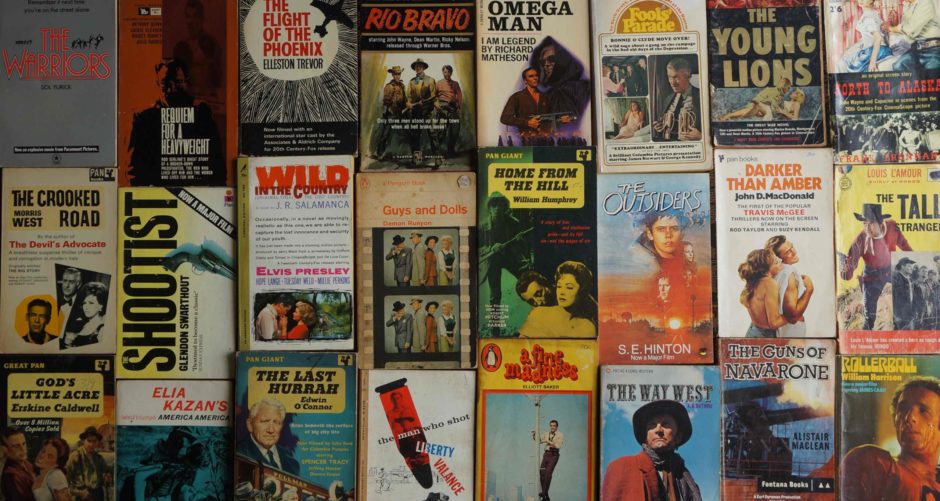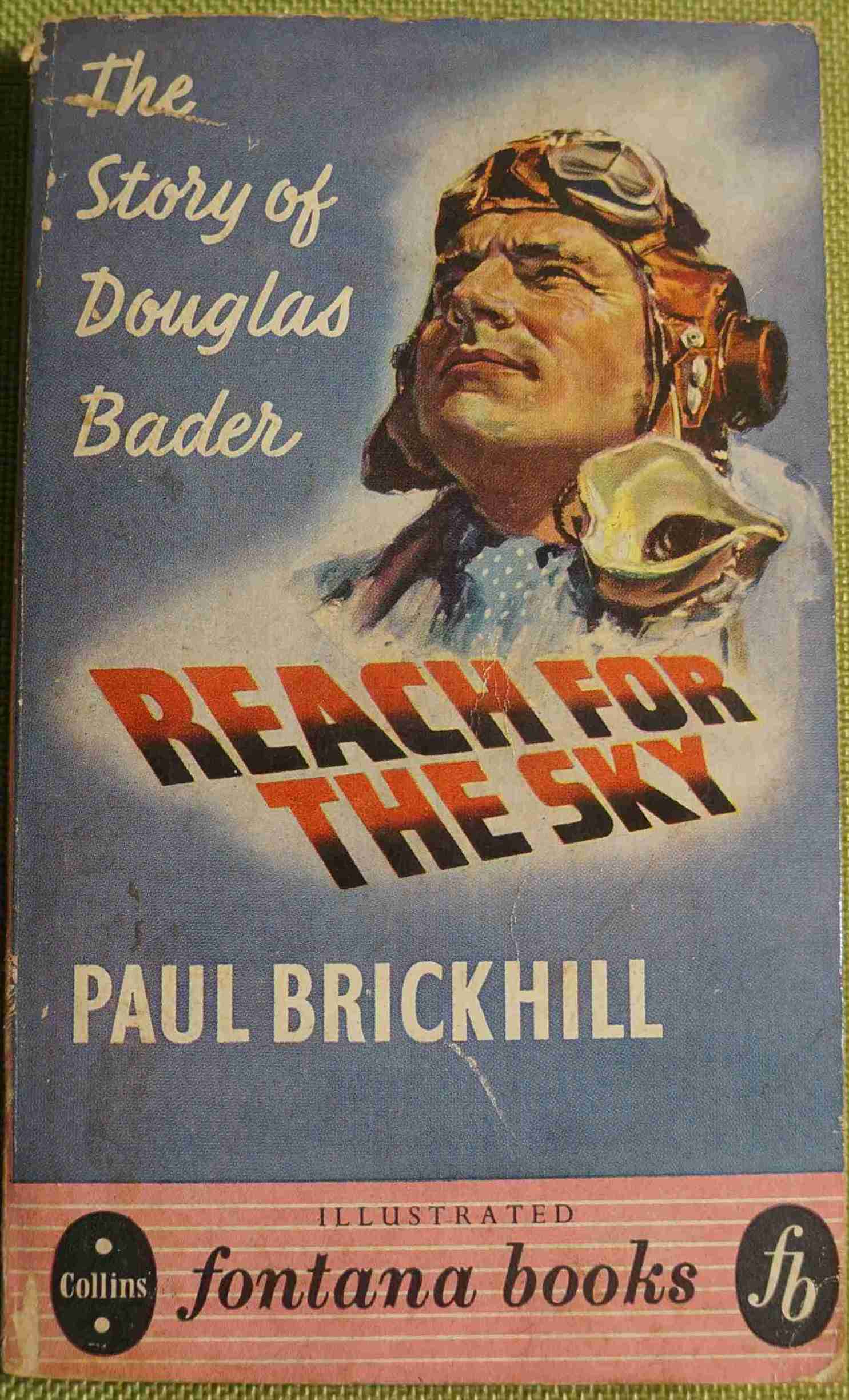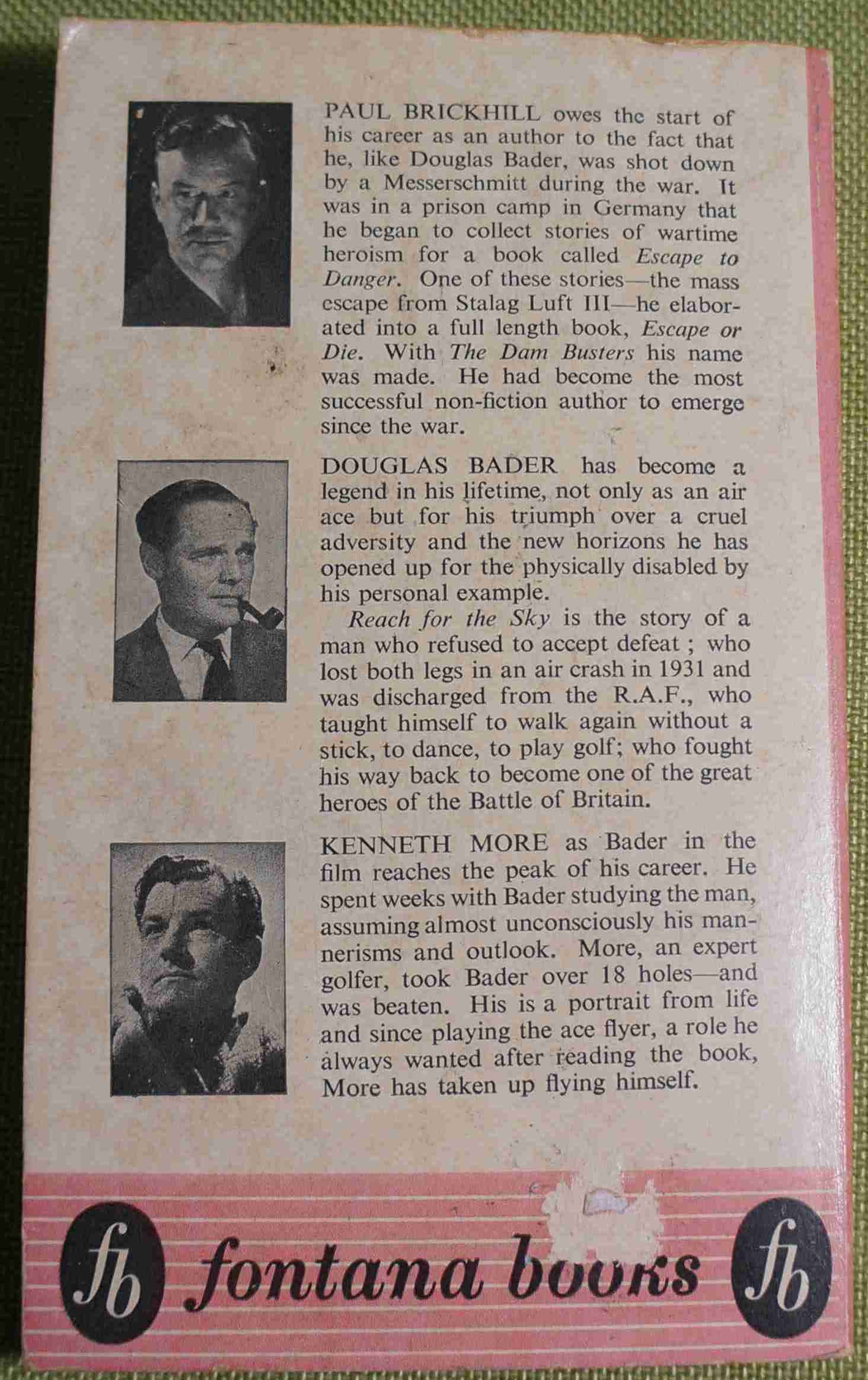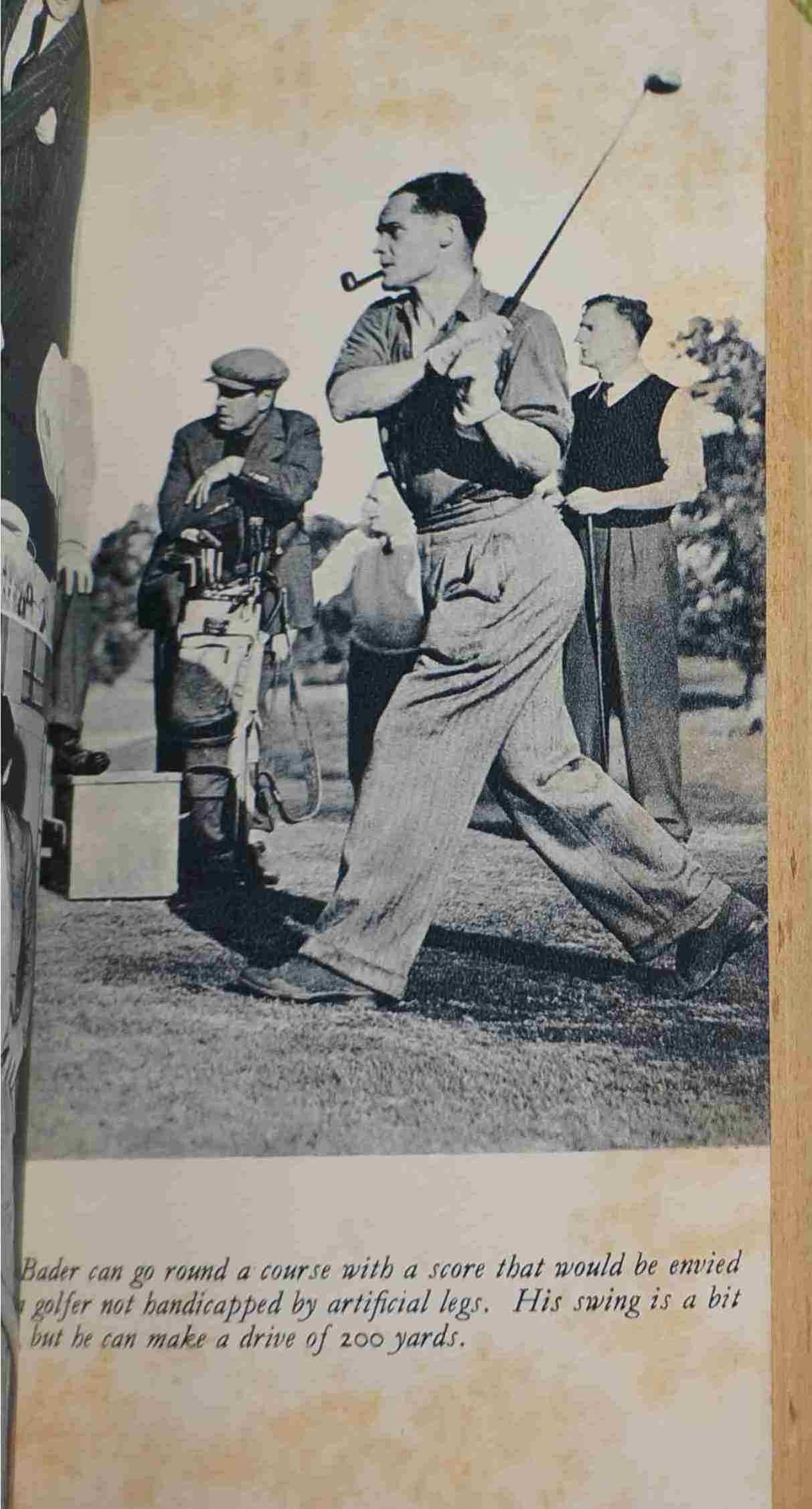FILM DIRECTOR: Lewis Gilbert
SCREENWRITER: Lewis Gilbert, Vernon Harris (additional scenes)
FILM STARS: Kenneth More, Muriel Pavlow, Lyndon Brook, Lee Patterson, Alexander Knox, Dorothy Alison, Michael Warre, Nigel Green, Eric Pohlmann, Michael Gough, Anton Diffring
COUNTRY: Britain
THIS BOOK
AUTHOR: Paul Brickhill
TYPE: Biography
PUBLISHER: Fontana
THIS EDITION PUBLISHED: 1957
COUNTRY: Great Britain
COVER: Paperback
THE ORIGINAL BOOK
ORIGINAL AUTHOR: As Above
YEAR FIRST PUBLISHED: 1954
ORIGINAL BOOK TITLE: The film title
NOTES
GENRE: War
WORDS: The British film industry seemed to be inundated with World War 2 films in the 1950s. There were dozens of them. They were mainly set in the European theatre of war with only a handful set in the Pacific theatre (I assume that is because there was nothing for them to crow about there).
Reach for the Sky (1956) is one of the most famous of the English WW2 films (it won the BAFTA Award for Best British Film of 1956 and was the most popular British film of the year). It is, also, I think, one of the most dreary of their WW2 films.
Apparently my lack of appreciation may be due to the fact I am Gen x
Filmink later argued the film “became acknowledged as a classic, unfairly mocked by Gen-X critics who were forced to watch it on television too many times, and who forget that the film was made by people and for audiences who had been through that conflict, many of whom had seen people die, and could view it in proper context.” https://en.wikipedia.org/wiki/Reach_for_the_Sky
I dispute that. My Gen X antecedents don’t prevent me from enjoying many other British war films from the 50s as well as propaganda war films from the 40s.
So, no, it’s just dreary.
The story of Douglas Bader is inspirational though apparently, according to a war buff friend of mine, the Bader character in the film (and perhaps in the biography) has been made more likeable than he was in real life.
Bader joined the RAF in 1928 and was injured in an aircraft accident which resulted in both his legs being amputated. He received prosthetic legs and at the outset of the war returned to the RAF and flew fighters during the Battle of Britain. He became a fighter ace (he was credited with 22 aerial victories, four shared victories, six probable, one shared probable and 11 enemy aircraft damaged). He was shot down in 1941, and only survived when he jettisoned from his aircraft in dramatic circumstances. One of his prosthetic legs was caught in the plane and he couldn’t jump free, his parachute had opened, which eventually caused his leg’s retaining strap to snap under the strain and he was pulled free. He was captured and sent to a German POW camp, he escaped, and was recaptured. He was such a nuisance that he was repeatedly moved from one POW camp to another, finally ending up in Colditz Castle. He was liberated after four years of captivity in 1945 by the First United States Army.
No wonder a biography and a film were made of him.
It may all be true, or largely true, but the film plays as if it was made during World War 2. There are no shades to Bader and the film comes across as a series of scenes building up to a flag waving ending.
Kenneth More is fine, and is the whole show. He plays Bader in the non nonsense unflappable way he played most of his characters, dramatic or comedic. There is no mid-century doubt or flaws in his character, or relatively little, he portrays Bader as if the film were a war movie made in 1944. There is nothing wrong with that though the film is a biopic as well as a war movie. Director Lewis Gilbert could do action dramas in his sleep (The Sea Shall Not Have Them (1954), Cast a Dark Shadow (1955), Carve Her Name With Pride (1956), Ferry to Hong Kong (1959), Sink the Bismark! (1960), H.M.S. Defiant (1962), The 7th dawn (1964)), as well as comedy dramas (Alfie (1966), Educating Rita (1983)) and straight comedies (The Admirable Crichton (1957) Light Up the Sky! (1960)), and big budget action ((Operation Daybreak (1975)), James Bond (You Only Live Twice (1967), The Spy Who Loved Me (1977) and Moonraker (1979)) and even horror (Haunted (1995)). And with the exception of the horror and Bond all the other genres he tackled are here in Reach for the Sky. And this is the problem. There is too much crammed in making the film are series of “acts” rather than a film (a problem with many biopics). Each one of the pivotal events in Bader’s life could have been a film by itself. When all are incorporated, following each other, with their own trajectories and resolutions the film becomes a very bitty. Acts should have bled into each other and there should have been a (strong) story arc in the background. With the flag waiving it becomes so much “ho hum”.
This and and the equally popular The Cockleshell Heroes (1955) are probably the least satisfactory of the 1950s English war films set in the European theatre. You would do much better with Gift Horse (1952), The Key (1958), Sea of Sand (1958), Morning Departure (1950), Above Us the Waves (1955), Appointment in London (1953), The Cruel Sea (1953), Ice Cold in Alex (1958), Malta Story (1953), The One That Got Away (1957 film), They Who Dare (1954) and then the stodgy but entertaining The Wooden Horse(1950), The Dam Busters (1955), and I Was Monty’s Double (1958).
I’m not inclined to read the book (which the film is faithful to in spirit if not in detail apparently) though no doubt it would be readable. Author Paul Brickhill (1916-1991) was an Australian fighter pilot, prisoner of war, and author who wrote Escape to Danger (with Conrad Norton) (1946), The Great Escape (1950), The Dam Busters (1951) and others, the last two being the basis of successful films. But Brickhill was a journalist, not a historian, who was writing a heart-warming and romanticised tale for commercial purposes. His Bader (and the one portrayed by More) was often far removed from the actual Douglas Bader, and unrecognisable by many (apparently) who served with him. Bader was stubborn, dogmatic, uncompromising, invariably knew best and only a team player when he was the leader of the team. He was also a product of his socio-educational background, he was patriotic, an imperialist and tended to see things in an us or them lens. I’m not sure if that’s what made his remarkable achievement in overcoming his disability, learning to walk on artificial limbs, and returning to operational flying, what it was, which is inspirational. Bader in the film overcomes every obstacle with relative ease and without (much) help (maybe he did in real life – I don’t know). But Bader, despite his comedic asides in the film, also remains one dimensional.
The not dissimilar film The Wings of Eagles (1957) by John Ford based on the life of World War 1 aviator Frank “Spig” Wead, who breaks his neck in a fall, is paralyzed, learns to walk again, before becoming a Hollywood screenwriter and then returns to active sea duty with the Navy in World War II is a more satisfying film. Wead’s achievements may be more modest than Bader’s but the film, which also covers many episodes in the man’s life and veers from slapstick comedy to drama, has a emotional (and central) arc running through the film – Wead’s relationship with his wife. It may be pure Hollywood but it makes the film feel like a film rather than a series of events. The colour, the great cast (John Wayne, Maureen O’Hara), the bigger budget and the usual high quality direction by John Ford don’t hurt either.
Bader’s story is, perhaps, ready for another film.
LINKS
TRAILER




Bader was an arsehole by all accounts, though his story was remarkable. I read the book when I was a boy and even then thought it was a bit pedestrian. I found the film to be underwhelming. The two other Brickhill books were turned into much better movies.
A post on The Cruel Sea would be interesting-the book is absolutely brutal in describing the horrors of war at sea and the film was quite graphic for the time.
Fun fact about ‘The Great Escape’, Peter Butterfield, one of the character actors in the Carry On movies, was shot down over Germany and held in the pow camp where the heat escape took place. When he auditioned for a supporting role in the movie he was turned down because he didn’t look like an airman.